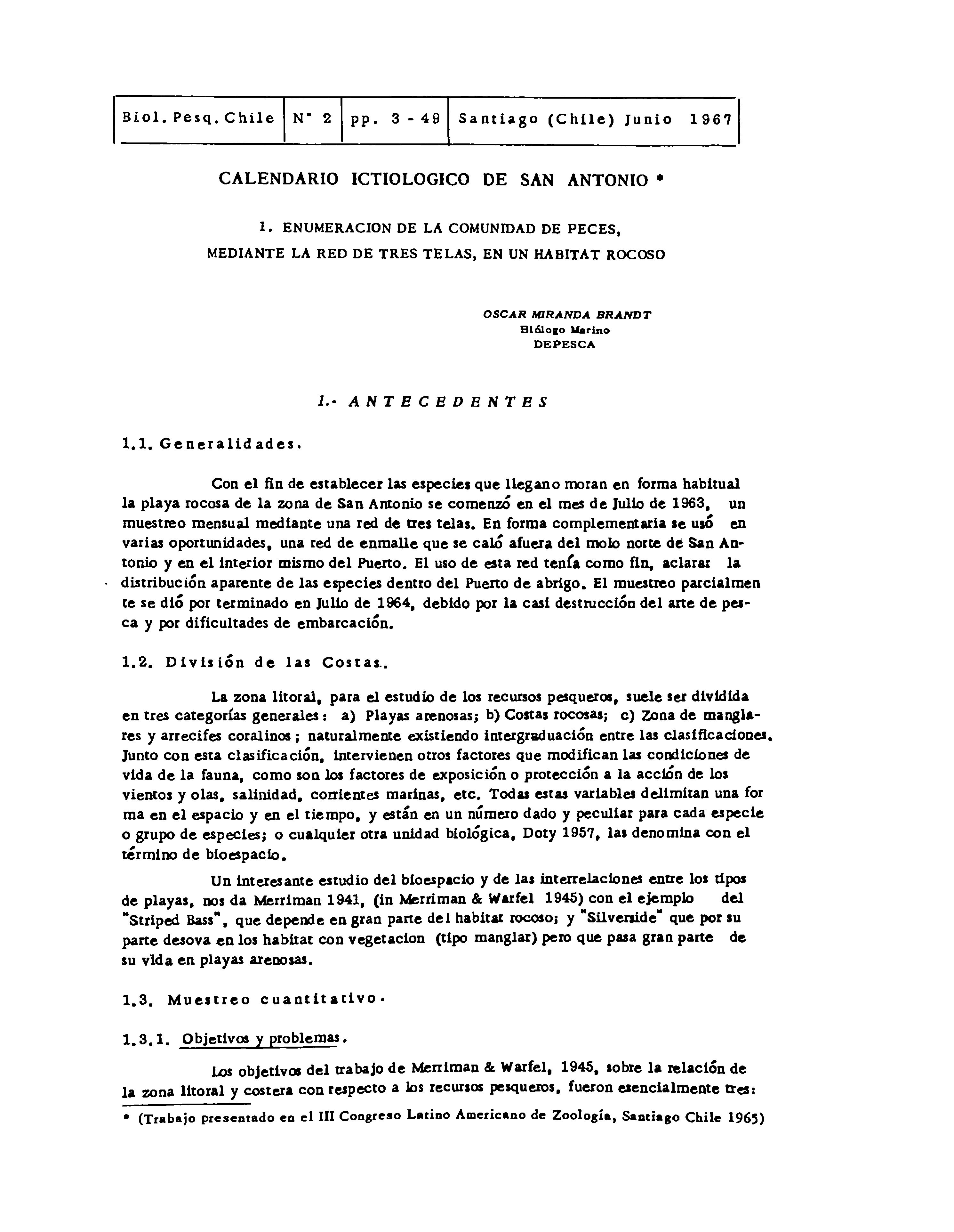Calendario Ictiológico de San Antonio
DOI:
https://doi.org/10.21703/0067-8767.1967.2.2363Abstract
The rocky shore of Ensenada Panul at the North of the Port of San Antonio, was sampled monthly using a trammel net, in order to identify the habitat species and determine some relation concerning their abundance and their yearly cycle of arrival. Tentatively the total, relative abundance of every species has been established.
Three quantitative methods were applied:
1.- The Warfel and Merriman method of yearly score. The most representative species are: A. punctatus; H. chilensis; S. oculatus; M. chilensis; Ch. variegatus. During a 10 month period, using monthly samplings, a total of 441 specimens were collected; 238 during the day and 203 at night. Of the total of 441 specimens 378 belonged to the previously mentioned species.
The number of species captured during the daytime were 20; 11 of these were also captured in the night hauls. The main day species is A. punctatus, an Herbivorous fish; 17 species were exclusively represented in the night captures. The dominant species of the habitat at night is S. oculatus, a carnivorous fish.
The greater species affinity is found at the end of the summer and the beginning of winter, with an intermixing group in springtime.
2.- With the percentage method three types of abundance curves were found: Type I with a maximum between May–June; Type II with a maximum between March–September (with A. punctatus a unique representative species); and Type III covering a larger period of appearance March–June but in fewer numbers.
The dominant species are discussed, and their food diet is taken into account.
3.- With the Motomura method, that relates the log of their quantity and score, a greater specimen density was found in summer night hauls. However, in the spring daytime hauls, a greater diversity of species and lower density was found.
During summer, daytime hauls the density was greater than the diversity.
In accordance with hauls at different depth; it seems that an exchange of territory by two species exists: Sebastodes oculatus, a carnivorous fish, dominates the shallow rocky water at night, but in the daytime it goes deeper, giving the space to A. punctatus, an herbivorous (seaweed-feeder) which was living deeper during the night time.
A discussion of the possibilities of the species not represented in the samples is included.
Finally, temperature and water transparency data were correlated with the abundance of the principal species.
The species groups appear more or less a month in advance in relation with the modes of temperature and transparency.
References
ALLEN, G.; DeLACY, A.; GOTSHALL, D. 1960. Quantitative Sampling of Marine Fishes – A Problem in Fish Behavior and Fishing Gear. Apartado de "Waste Disposal in the Marine Environment" Pergamon Press. pp. 448–511. Univ. of Washington, College of Fisheries: Contribution N° 70.
BEVERTON, R. J. H. & S. J. HOLT. 1957. On the Dynamics of Exploited Fish Populations – Fishery Investigation Serie 11 Vol. XIX. pp. 533. Ministry of Agriculture. Fisheries and Food, London. H. M. Stationery Office.
CLARKE, GEORGE L. 1958. Elementos de Ecología. Ediciones Omega, S.A. Barcelona, pp. 615.
DOTY, MAXWELL S. 1957. Rocky Intertidal Surfaces. Geol. Soc. America. Memoir 67, Vol. 1. p. 535–585, 18 Figs. 1 pl.
GRAHAM, MICHAEL. 1956. Sea Fisheries. Their Investigation in the United Kingdom. Edward Arnold (Publishers) Ltd. London, pp. 487.
HELA, ILMO & TAIVO LAEVASTU. 1961. Fisheries Hydrography. Fishing News (Books) Ltd. London. pp. 128.
KETCHEN, K. S. 1956. Climatic Trends and Fluctuations in Yield of Marine Fisheries of the Northeast Pacific. J. Fish. Res. Bd. Canada 13 (3): 357–374.
MANN, GUILLERMO. 1957. La vida de los Peces en Aguas Chilenas. Stgo. Chile pp. 342.
MARR, JOHN. 1957. Contributions to the study of subpopulations of Fishes. S.S.R. N° 208. U.S. F.W.S. Washington.
MERRIMAN, DANIEL & HERBERT E. WARFEL. 1945. The relation of the shore and Beach Zone to Fisheries Resources. Dep. April 1945. Shore and Beach – journal of the American Shore and Beach Preservation Association.
MOTOMURA, I. 1932. (En japonés) Zool. Mag. 44: 379–383.
P. FONT QUER. 1953. Diccionario de Botánica. Ed. Labor, S.A. España.
RICKER, W.E. 1958. Handbook of computations for biological statistics of fish population. Bull. 119 Fish. Bd. Canada.
ROLLEFSEN, G. 1949. The Selectivity of different fish gear used in Lofoten. J. Conseil Explor. Mer. 19: 191–194 (Obra no consultada, ref. in Ricker)
SEVERTZOV, S.A. 1941. Dinámica de la Población Animal. Empresa Ed. "Austral" Ltda., Santiago, Chile, 1947.
SNEDECOR, GEORGE. 1959. Statistical Methods. Fifth Edition. The Iowa State College Press. Ames, Iowa.
SAETERSDAL, G. 1963. A note on the Methods used in Mesh Selection Experiments. ICNAF. Spec. Publ. N° 5, p. 185–188.
TULLY. 1960. Seasonal cycles in the Sea. Progress Reports of the Pacific Coast Stations of the Fisheries Research Board of Canada, N., pp. 88–90.
YAMAMOTO, GOTARO. 1950. Benthic Communities in Mutsu Bay. Science Report of Tohoku University, 4th Series (Biology) (4): 482–487.
Ibidem. 1952. Seasonal Changes of Benthonic Communities and the Succession in the Benthos caused by the Production of Scallop. The Science Reports of the Tohoku University, 4th Series Biology.




